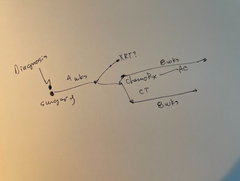Guest post by our cancer coach, Dr. B.
In a previous Manta Cares Newsletter, Samira introduced us to The Life Audit Wheel. This is probably my favorite coaching tool to use in my practice. Why? It provides a great overview of where the client currently is in their life compared to where they would like to be. It gives us a concrete visual to work with and refer back to throughout the coaching relationship.
What is the Life Audit Wheel? It is a self-assessment tool, in which the client rates aspects of their life that are important to them (for example: career, growth, intimate relationships, fitness, health, nutrition, sleep, concentration...) according to how content or fulfilled they feel in each category. This step quickly uncovers areas of imbalance in their life. They then rate each category according to how important it is to them. This second step is important because it gives us clarity around their priorities and where we can most effectively focus our energy. Just because one area is rated poorly does not mean that they have to or want to start there.
The Wheel is a holistic, visual representation of the client's life priorities, where they are today, and where they would like to be. It looks different for each client and therefore gives me as their coach invaluable insights into their unique world. It acts as our North Star, giving us direction. Is what we are currently doing bringing us closer to where the client wants to be on the Wheel?
The Wheel is not unique to coaching. In medicine, I used a similar tool during weekly interdisciplinary meetings in geriatric internal medicine and rehabilitation, in which representatives from physical therapy, social work, medicine, nursing, speech-language pathology, home health, and nutrition sat together to discuss patients. We used a wheel tool to assess and visualize domains such as physical health, mental health, activities of daily living, gait, nutrition, cognition, psychological status, social circumstance, home environment, etc. Seeing where the patient stands in specific categories compared to where they need to be before discharge gave us a clear picture of where we need to increase our efforts in order to get them home safely.
It is important to note that, in life, we cannot be completely in balance 100% of the time. There are seasons or phases in which we need to focus more energy and time on certain aspects of our lives, and as a result other domains fall short. Think: exams week, call shifts, delivering and nurturing a baby... While maintaining some form of balance would likely improve your wellbeing and performance during these times, there is likely some form of imbalance occurring. This is not a bad thing and it is not forever! The key is not chronically neglecting or completely losing sight of the other domains. This is where the Wheel has played an important role in my life. During long on-call weeks and night shifts, my coffee consumption often increased and my nutrition and fitness needs fell short. My private life shrunk to a mere minimal existence. These periods were tough for me mentally and physically, however when I learned about the Wheel, I felt more in control. I knew what was important to me and what made me feel better and helped me show up as the person and doctor I wanted to be. It helped me get back on track after those life-disrupting phases in medical school and residency.
The Wheel is also something I turn to during and after traveling, as my schedule and routines often go out the window during these times. Ever felt in a rut when you get home from a vacation? Then you know what I mean!
Have you used the Life Audit Wheel before? I encourage you to give it a try. I would be curious to know what comes up for you. Feel free to reach out or bring your insights to a complimentary exploratory session!





